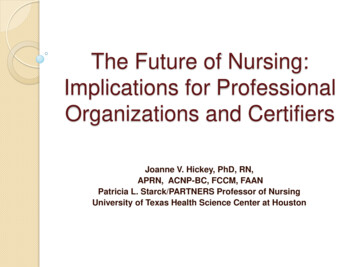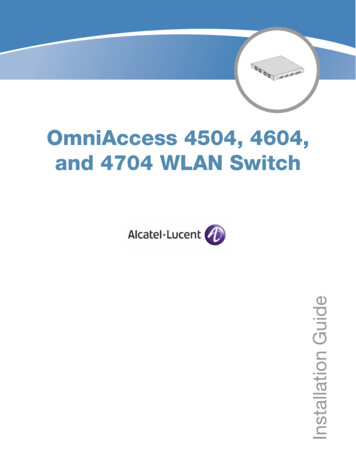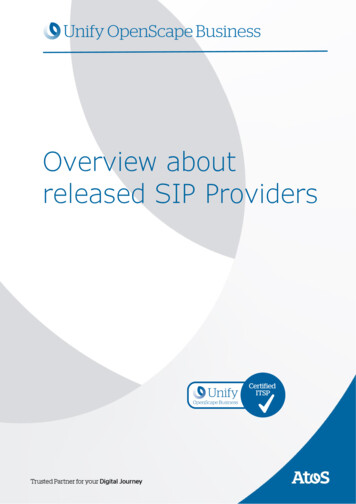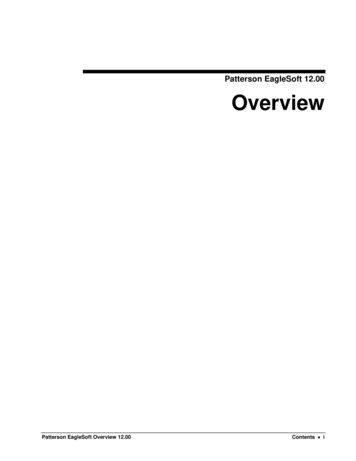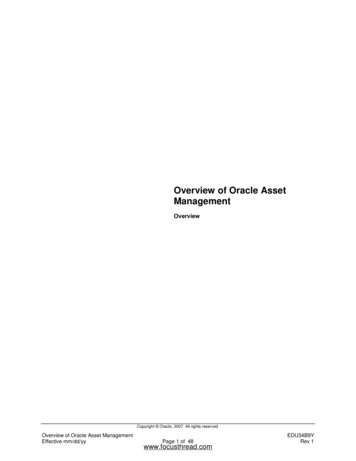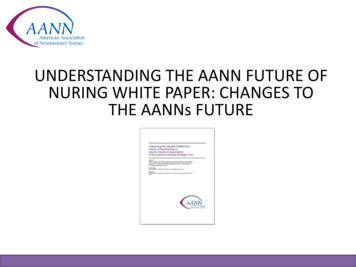
Transcription
UNDERSTANDING THE AANN FUTURE OFNURING WHITE PAPER: CHANGES TOTHE AANNs FUTURE
INTRODUCTION:HEALTHCARE REFORM March 2010:President BarackObama signed intolaw the PatientProtection andAffordableHealthcare Act(PPACA)
INTRODUCTION:HEALTHCARE REFORM & NURSING October 2010: The Institute of Medicine Published a report“The Future of Nursing: Leading Change, Advancing Health”– Four Key Messages– 1. Nurses should practice to the full extent of their education andtraining– 2. Nurses should achieve higher level of education and trainingthrough an improved education system that promotes seamlessacademic progression– 3. Nurses should be full partners, with physicians and otherhealthcare professionals in redesigning U.S. healthcare– 4. Effective workforce planning and policy making require betterdata collection and an improved information infrastructure
INTRODUCTION:AANN RESPONSE July 2011: AANN Board ofDirectors (BOD) Adopted the 4 key messages ofthe IOM Future of Nursing callto action and integrated theminto the AANN strategic plan. June 2012: AANN published itsfirst White Paper “Integrating the Institute ofMedicine Future of NursingReport into the AmericanAssociation of NeuroscienceNurses Strategic Plan”
Key Message #1:
Key Message #1What does this meanfor AANN members? Neuroscience nurses must be able to practiceto the full extent of their education regardlessof whether they are working as a registerednurse or an advanced practice nurse; andregardless of the setting.
Subcategory 1:Scope of PracticeSubcategory 2:Transition to Practice (NurseResidency) programs1.1.Revision of the AmericanAssociation of Neuroscience Nurses(AANN) Scope and Standards ofPractice for Registered Nurses andadvanced practice registered nurses(APRNs)2.Implement multilevel residencyprograms to manage entranceinto neuroscience nursing (e.g.,student to practitioner).Programs to manage positionsof greater oversight (e.g.,practitioner to coordinator,coordinator to director).
Key Message #1:How can AANN accomplish this?1. Collaborate with the American NursesAssociation (ANA) on the scope andstandards of practice document.2. Support ANA scope and standards of practiceupdates.3. Disseminate the revised scope and standardsof practice document to key stakeholders.
Subcategory 1:Scope of PracticeSubcategory 2:Transition to Practice Programs1.1.Integration of the AmericanAssociation of Neuroscience Nurses(AANN) Scope of Practice foradvanced practice registered nurses(APRNs) with those of bedsidenurses to support excellence in theneurosciences.2.Support the implementation ofmultilevel residency programsto manage entrance intoneuroscience nursing (e.g.,student to practitioner).Support programs to managepositions of greater oversight(e.g., practitioner tocoordinator, coordinator todirector).
Key Message #1How can AANN accomplish this?1. Support transition-to-practice graduate nurse residencyprograms.2. Support the development of a competency-basedtransition-to-practice (nurse residency) program for entryinto the neuroscience nursing subspecialty.3. Support and facilitate the implementation of multilevelnurse residency programs across the continuum of care.4. Prepare an AANN position statement on competencybased transition-to-practice (nurse residency) programsfor neuroscience.5. Disseminate the AANN position statement to keystakeholders.
DISCUSSION Who are your key stakeholders? How do you disseminate information tostakeholders?
Key Message # 2Nurses should achieve higher levelsof education and training through animproved education process thatpromotes seamless academictransition.
Key Message #2What does this mean forAANN members? We need to have opportunities for higherlevels of education specific to neurosciencenursing. We need to have quality educationalresources that support our educational needs.
Key Message #2How can AANN accomplish this? Achieve industry-wide reputability as a producer ofquality education products– Foster a culture of lifelong learning AANN is a continuing education provider– Support the use of traditional and alternative educationalmethodologies Face to face, online, distance, simulation– Support development of a comprehensive core of clinicalperformance competencies– Continue to disseminate research-based best practices AANN Clinical Practice Guidelines (CPGs) Journal of Neuroscience Nursing
Key Message#2How can AANN accomplish this? Explore the global market to provideeducation in neuroscience nursing– Create opportunities for entrepreneurialprofessional development education Enables neuroscience nurses to consider startingbusinesses intended to improve healthcare outcomes– Disseminate innovative evidence-based caremodels– Explore opportunities and introduce neweducational products
DISCUSSION What educational tools or opportunitieswould be most valuable to advancing yourclinical and professional practice? What types of evidenced-based education orprograms would meet your needs?
Key Message #3Nurses should be full partners, withphysicians and other healthcareprofessionals, in redesigning U.S.healthcare
Key Message #3What does this mean forAANN members? We need to be able to collaborate with otherdisciplines to redesign neurosciencehealthcare We need to develop leadership skills to beable to move fluently from the “bedside to theboardroom” We need to be able to engage with strategicpartners and coalitions to shape the way wecare for patients
Key Message #3How can AANN accomplish this? Provide educational opportunities for leadershipdevelopment across all levels (public, private,governmental)– Support the development and dissemination ofbeginner through advanced leadership competencies– Support the development and dissemination ofnursing leadership training programs Colleges/universities, organizational– Support educational programming within our ownorganization to develop leaders
Key Message #3How can AANN accomplish this? Facilitate fellowship/mentor programs fornursing leaders across all levels– Mentorships within industry, healthcareorganizations, universities, government– Provide avenues in available fellowshipopportunities (quality, research, access, value ofhealthcare)– Explore fellowship opportunities with our strategicpartners
Key Message #3How can AANN accomplish this? Provide opportunities to lead within our ownorganization for all members– Improve our networking opportunities andoptions– Support our existing leaders, and mentor our newleaders– Increase opportunities to volunteer at both theregional and national level– Develop a program for leadership development atour annual conference
DISCUSSION What type of leadership training would meetyour clinical needs? What type of leadership training would meetyour professional needs? What are some of the barriers to volunteeringfor positions, and how can we remove thosebarriers?
Key Message #4Effective workforce planning andpolicy making require better datacollection and an improvedinformation infrastructure
Key Message #4What does this mean forAANN members? We need workforce capacity data to developnew models of care for the future We need to increase our partnerships andcoalitions at a national level to invest ininformation systems, data collection, datamining, and to influence decisions makers onhealth policy
Key Message #4SubcategoriesEffective PlanningPolicy Making Data regarding the healthcareworkforce must be accuratelycollected and analyzed The AANN strategic plan hasidentified the goal to“influence the advancement ofthe field of neurosciences” Workforce data is key fordevelopment of projectionmodels regarding the workforceneeds that will be instrumental tothe transformation of nursingpractice and education The AANN Board of Directorsrecognizes the need to engagein discussions with multiplestakeholders to monitor healthpolicy issues and align withother organizations to obtainthe necessary data
Key Message #4 Effective PlanningHow can AANN accomplish this? Invest in information systems and technology– AANN is an organizational affiliate of ANA Conduct thoughtful data collection and datamining for data driven decision making Develop partnerships and coalitions at thenational level to more effectively plan for thesubspecialty of neuroscience nursing
Key Message #4 Effective PlanningHow can AANN accomplish this? Engage the membership in the planning andimplementation processes Review and update the organizationalstrategic plan in light of landmark reports. Engage in discussions with a variety ofstakeholders regarding effective planning
Key Message #4 Policy MakingHow can AANN accomplish this? Establish relationships with mission similar organizationsand identify the primary purpose of these relationships Establish the organizational role in advocacy.– AANN Advocacy Statement– Standing Advocacy Committee Charge is to develop policies, procedures, and criteria for theorganizational role in advocacy Recognize and prioritize needs and engage in selectpolitical actions Understand and disseminate how health policy andrelated changes affect the organization (governances andmembership).
Key Message #4 Policy MakingHow can AANN accomplish this? Create a strategic communication plan in order toinfluence decision makers. Develop partnerships and coalitions at the nationallevel to gain influence for the neuroscience nursingsubspecialty. Monitor healthcare policies and issues related tohealthcare reform. Assess the actual or potential transformative effectof policies on neuroscience nursing practice and theorganization overall.
DISCUSSION Who do you see as your key stakeholders inmonitoring health policy? How do you get your information regardinghealth policy and changes?
CONCLUSION AANN has adopted the 4 key messages of theIOM Future of Nursing Report into the strategicplan of the organization. AANN has created a white paper specific to theneeds for neuroscience nurses to provide ablueprint to lead change and advance health AANN is committed to educating its membershipon the goals of the Future of Nursing White Paperto ensure successful implementation within theneuroscience nursing community
HEALTHCARE REFORM & NURSING October 2010: The Institute of Medicine Published a report “The Future of Nursing: Leading Change, Advancing Health” –Four Key Messages –1. Nurses should practice to the full extent of their education and training –2. Nur

